Author's Purpose
"Why Good Advertising Works (Even When You Think It
Doesn't)"

Unit Overview
The
learning objective of this unit is to develop a comprehensive understanding of
the author's purpose, analyze the connotation and denotation of words, and
explore the impact of adjectives in a point-of-view article. By examining the
author's intent behind their writing, evaluating the underlying meanings of
words, and examining the role of adjectives in shaping perspectives, learners
will enhance their critical thinking skills and gain a deeper appreciation for
the nuances of language in persuasive and argumentative texts.
Author's Purpose
Understanding
the purpose behind an author's writing is crucial for readers. By uncovering
the author's intention or goal, we can gain deeper insight into the message and
engage more effectively with the text. This section will explore the authors' purposes,
including persuasion, information, and entertainment.
By examining specific cues within the text, we can unravel the author's purpose
and enhance our overall comprehension.
An author's
purpose can be to persuade, inform, or entertain readers. When authors seek to
inform, they aim to provide information or teach readers something practical.
This type of writing is characterized by using facts and objective details. By
presenting factual information, authors establish credibility and aim to
enhance readers' knowledge or understanding of a subject.
To
distinguish the author's purpose, distinguishing between facts and opinions is
essential. Facts are verifiable and can be proven, while opinions are
subjective and based on personal beliefs or feelings. Phrases like
"think," "believe," "feel," "best,"
"worst," and "must" often indicate that an author is
expressing an opinion. When opinions are present, the author's purpose may be
to persuade
readers, attempting to convince them of a particular viewpoint or
course of action.
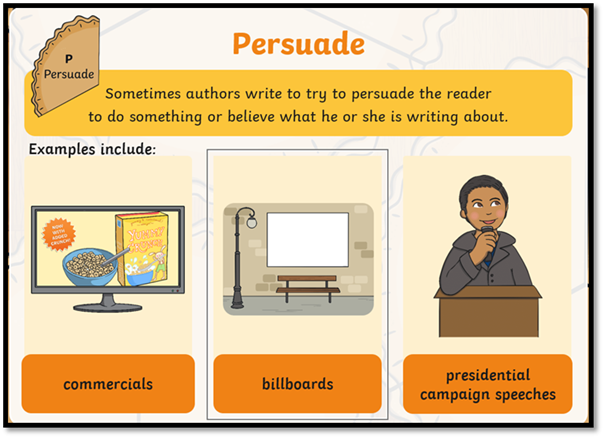
Argumentative
writing often incorporates informative elements, as authors may
use facts and evidence to support their opinions. Authors aim to sway readers'
opinions or behaviors by providing logical reasoning and persuasive arguments.
Recognizing the blend of information and persuasion within a text helps us more
accurately identify the author's purpose.
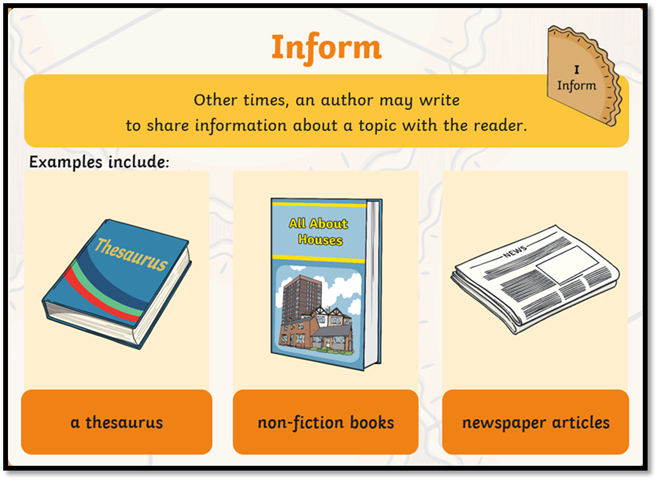
In addition
to persuasion and information, authors may write with the purpose of entertaining
their readers. When the aim is to entertain, authors often utilize humor,
whimsical details, or storytelling elements such as characters, settings, and
plots. This type of writing captivates readers' attention, sparks their
imagination, and provides enjoyment through creative narratives or amusing
anecdotes.
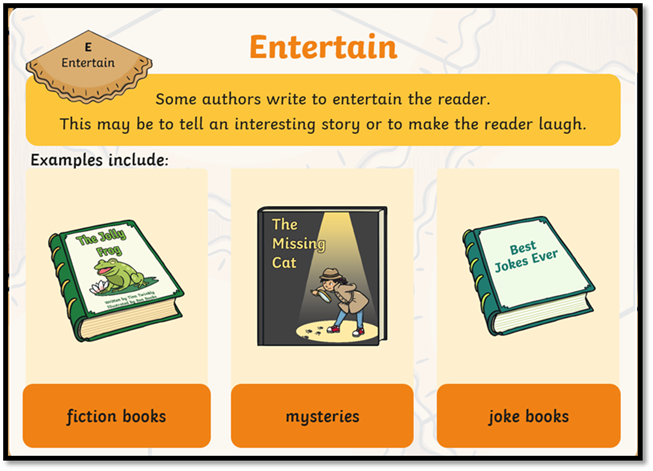
Understanding
the author's purpose empowers readers to engage more effectively with the text.
By recognizing whether the author intends to persuade, inform, or entertain, we
can better comprehend the underlying message and the impact the writing seeks
to have on us. By examining specific cues within the text, such as the presence
of facts, opinions, or humorous elements, we can discern the author's purpose
with greater clarity. Developing this skill enhances our ability to critically
analyze and appreciate the intentions behind an author's words, ultimately
deepening our overall understanding and engagement with written works.
Let’s Practice
Connotative and Denotative
Language is
a powerful tool for expressing thoughts, ideas, and emotions. As English
students, understanding the nuances of language becomes essential. Two
significant aspects of word meanings are connotation and denotation. This section
will explore the differences between connotative and denotative meanings and
how they shape our communication.
Denotative
Meaning:
Denotative
meaning refers to a word's literal or dictionary definition. It represents the
objective and universally understood interpretation of a term. We convey a
clear and straightforward message when we use words in their denotative sense.
For example, "home" denotes a physical dwelling place where someone
lives.
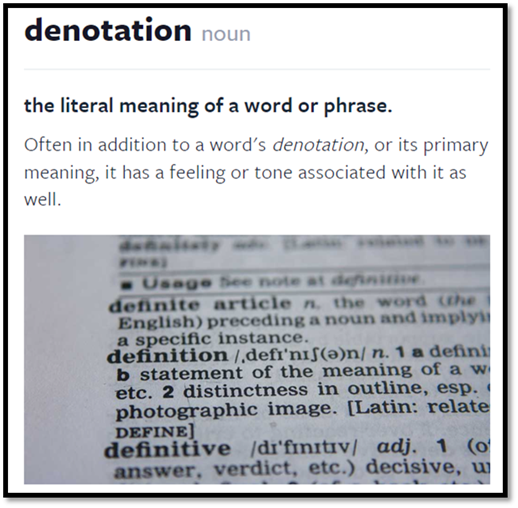
Connotative
Meaning:
On the
other hand, Connotative meaning delves into the subjective and emotional
associations attached to a word. It goes beyond the literal definition and includes
the feelings, attitudes, and cultural references associated with a term. Personal
experiences, societal norms, and historical context shape connotations. For
instance, "home" can evoke warmth, comfort, and belonging.
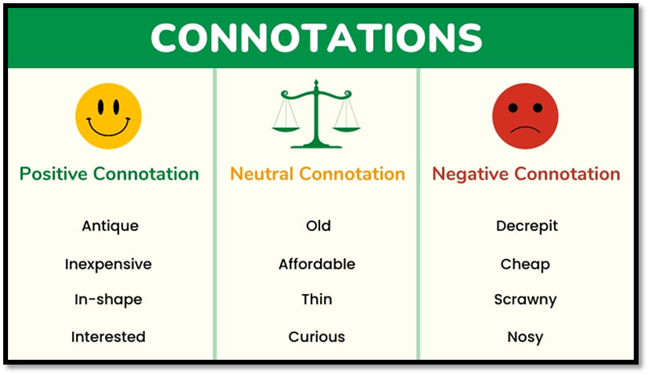
Examples of
Connotation and Denotation:
To better
grasp the difference between connotative and denotative meanings, let's explore
some examples:
1. Dog:
· Denotative meaning: A domesticated mammal typically kept as a pet or used for
guarding or hunting.
· Connotative meaning: Can vary depending on personal experiences and cultural
backgrounds. Some may associate dogs with loyalty, companionship, or even fear.
2. Snake:
· Denotative meaning: A long, legless reptile with a cylindrical body.
· Connotative meaning: Often associated with negative traits such as deceit, danger,
or evil. However, some cultures view snakes as symbols of wisdom or
transformation.
3. Old:
· Denotative meaning: Having lived for a long time; no longer young.
· Connotative meaning: Can evoke various emotions depending on the context. It may
connote wisdom, experience, or respect but suggest frailty or obsolescence.
Importance
of Understanding Connotation and Denotation:
1. Effective Communication: Recognizing words' connotative and denotative meanings helps
us choose appropriate language to convey our intended message accurately. It
allows us to understand and utilize the subtle nuances of language to express
ourselves more effectively.
2. Literary Analysis: Recognizing connotations enriches our understanding of the
author's intentions and thematic elements when analyzing literature. It enables
us to explore deeper layers of meaning and appreciate the text's artistic
qualities.
3. Cultural Sensitivity: Connotations are influenced by culture and society.
Understanding connotative meanings helps us navigate intercultural
communication by being mindful of the potential emotional impact of our words.
Connotative
and denotative meanings play pivotal roles in our language and communication.
While denotation provides a literal definition, connotation adds depth,
emotion, and cultural associations to words. As English students, developing an
awareness of both aspects empowers us to become more effective communicators,
critical thinkers, and appreciators of language's artistry.
Top of Form
Let’s Practice
Working with Adjectives
Adjectives
are essential to English grammar as they help us describe and provide more
information about nouns and pronouns. By using adjectives, we can answer
questions such as "What kind?", "Which one?", "How
many?" and "How much?" Let's explore these concepts further to
enhance our understanding of adjectives.
1. What Kind?
Adjectives
that answer the question "What kind?" describe the quality or
characteristic of a noun. They help us understand the specific type or category
of the described noun.
For
example:
- The adorable puppy wagged its tail.
- She wore a beautiful dress to the party.
- I enjoyed a refreshing glass of cold lemonade.
In these
sentences, the adjectives "adorable," "beautiful," and
"cold" provide additional information about the noun, conveying the
type or quality of the puppy, dress, and lemonade.
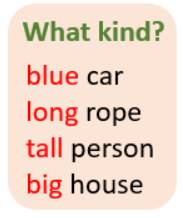
2. Which One?
Adjectives
that answer "Which one?" help us identify or specify a particular
noun from a group. These adjectives indicate the noun's position, order, or
relationship to other nouns.
Consider
the following examples:
- I prefer the blue shirt over the red
one.
- This is the oldest building in the city.
- The book on the top shelf is mine.
Here, the
adjectives "blue," "red," "oldest," and
"top" help us distinguish one noun from another, indicating a
specific item or location.
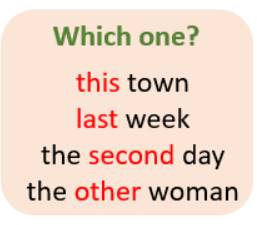
3. How Many?
Adjectives
that answer the question "How many?" provide information about the
quantity or number of nouns. They indicate whether the noun is singular or
plural.
Take a look
at these examples:
- There are seven cats in the backyard.
- She received a few letters in the mail.
- I need two cups of sugar for the recipe.
The
adjectives "seven," "few," and "two" give us an
idea of the quantity or number of cats, letters, and cups mentioned in the
sentences.
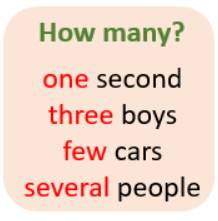
4. How Much?
Adjectives
that answer the question "How much?" describe the amount or degree of
a non-countable noun, usually related to things that cannot be easily counted.
Consider
these examples:
- He drank a little water after the workout.
- She has a great deal of knowledge about history.
- They showed immense courage during difficult times.
In these
sentences, the adjectives "little," "great deal of," and
"immense" provide information about the amount or extent of water,
knowledge, and courage mentioned.
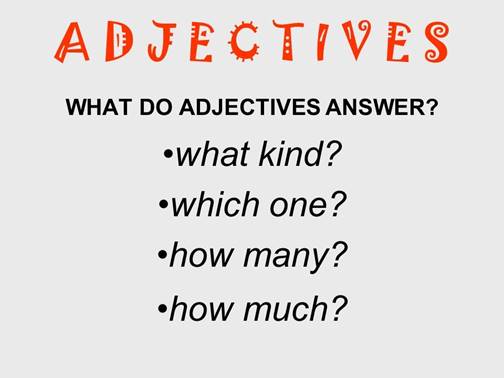
Remember,
adjectives are crucial in adding depth and detail to our descriptions. By
understanding how adjectives answer questions such as "What kind?",
"Which one?", "How many?" and "How much?" we can
effectively communicate and paint a vivid picture with our words.
Let’s Practice
"Why Good
Advertising Works (Even When You Think It Doesn't)"
by Nigel Hollis

You will
have two ways to read and complete the activities.
1. Click here to get a download copy of the reading activity.
2. Click here to sign up for an online version of the reading activity
through CommonLit. (Code: F6SRJ9UF)
The target
lesson will have five parts.
·
Part 1 - Writing Warm-Up
·
Part 2 - Review Today's Target: Analyzing the Author's Point of
View
·
Part 3 - Reading and Questions
·
Part 4 - Assessment